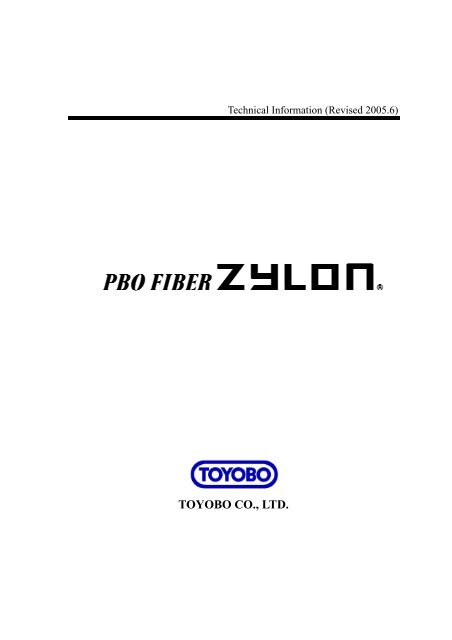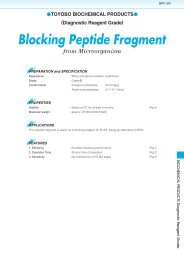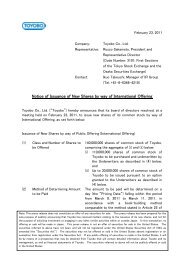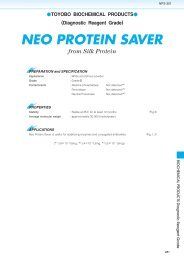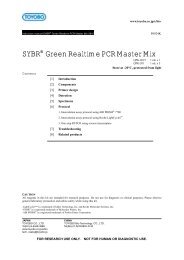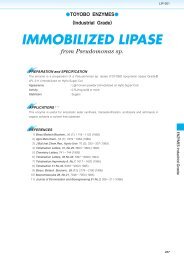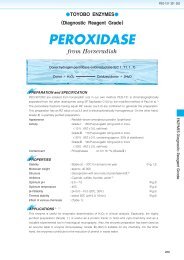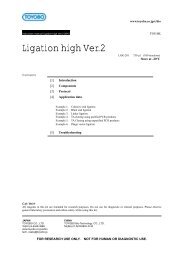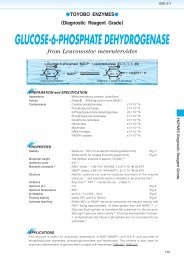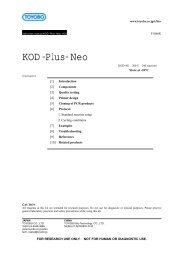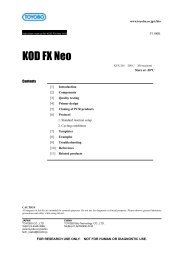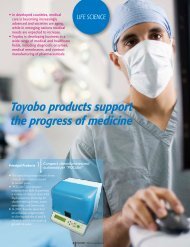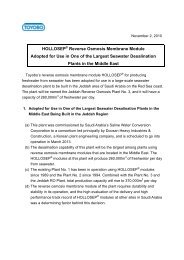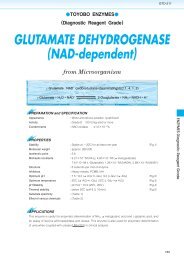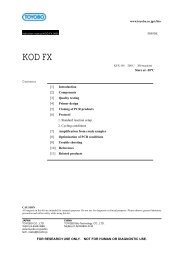Zylon Technical_Information.pdf - Metal Clad Fiber
Zylon Technical_Information.pdf - Metal Clad Fiber
Zylon Technical_Information.pdf - Metal Clad Fiber
Create successful ePaper yourself
Turn your PDF publications into a flip-book with our unique Google optimized e-Paper software.
<strong>Technical</strong> <strong>Information</strong> (Revised 2005.6)<br />
TOYOBO CO., LTD.
ZYLON ® (PBO fiber) <strong>Technical</strong> <strong>Information</strong> (2005)<br />
Contents<br />
1. Basic properties<br />
2. Comparison with other high-performance fibers<br />
3. Influence of twist on tensile properties<br />
4. Creep properties<br />
5. Thermal behavior<br />
5.1 TGA Analysis<br />
5.2 Isothermal weight loss<br />
5.3 Strength retention after thermal treatment<br />
5.4 Strength retention at high temperature with humidity<br />
5.5 Effect of temperature on strength and modulus<br />
5.6 Hot air shrinkage<br />
5.7 Flame resistance<br />
5.8 Combustion products<br />
6. Light resistance<br />
7. Chemical resistance<br />
7.1 Organic mediums<br />
7.2 Inorganic mediums<br />
7.3 Seawater<br />
8. Moisture pick-up<br />
9. Miscellaneous<br />
9.1 Compressive strength<br />
9.2 Knot and loop strength<br />
9.3 Thermal expansion coefficient<br />
9.4 Heat capacity<br />
9.5 Abrasion resistance between fiber and metal<br />
2
1. Basic Properties<br />
ZYLON ® (PBO fiber) is the next generation super fiber with strength and modulus almost<br />
doubles that of p-Aramid fiber. ZYLON ® shows 100°C higher decomposition temperature<br />
than p-Aramid fiber. The limiting oxygen index is 68, which is the highest among organic<br />
super fibers.<br />
There are two types of fibers, AS (as spun) and HM (high modulus). HM is different from<br />
AS in modulus, moisture regain and etc.<br />
ZYLON ® AS ZYLON ® HM<br />
Filament decitex 1.7 1.7<br />
Density (g/cm 3 ) 1.54 1.56<br />
Tensile Strength (cN/dtex) 37 37<br />
(GPa) 5.8 5.8<br />
(kg/mm 2 ) 590 590<br />
Tensile Modulus (cN/dtex) 1150 1720<br />
(GPa) 180 270<br />
(kg/mm 2 ) 18000 28000<br />
Elongation at break(%) 3.5 2.5<br />
Moisture regain(%) 2.0 0.6<br />
Decomposition Temp.(°C) 650 650<br />
LOI 68 68<br />
Thermal expansion coefficient - -6x10 -6<br />
2. Comparison of mechanical properties with other fibers<br />
ZYLON ® has the highest tensile strength and tensile modulus among high-performance<br />
fibers.<br />
Tenacity<br />
Modulus<br />
Elongation<br />
Density<br />
Moisture<br />
Regain<br />
LOI<br />
Heat<br />
Resistance*<br />
cN/dtex GPa cN/dtex GPa % g/cm 3 % C<br />
<strong>Zylon</strong>® AS 37 5.8 1150 180 3.5 1.54 2.0 68 650<br />
<strong>Zylon</strong>® HM 37 5.8 1720 270 2.5 1.56 0.6 68 650<br />
p-Aramid(HM) 19 2.8 850 109 2.4 1.45 4.5 29 550<br />
m-Aramid 4.5 0.65 140 17 22 1.38 4.5 29 400<br />
Steel <strong>Fiber</strong> 3.5 2.8 290 200 1.4 7.8 0<br />
HS-PE 35 3.5 1300 110 3.5 0.97 0 16.5 150<br />
PBI 2.7 0.4 45 5.6 30 1.4 15 41 550<br />
Polyester 8 1.1 125 15 25 1.38 0.4 17 260<br />
*Melting or Decomposition Temperature<br />
3
The stress-strain curves of ZYLON ® compared with other high-performance fibers are<br />
shown below.<br />
6<br />
5<br />
Stress(GPa)<br />
4<br />
3<br />
2<br />
1<br />
0<br />
<strong>Zylon</strong> AS<br />
<strong>Zylon</strong> HM<br />
p-Aramid<br />
p-Aramid HM<br />
copoly-Aramid<br />
Carbon<br />
0 1 2 3 4 5 6<br />
Strain (%)<br />
3. Influence of twist on tensile properties<br />
ZYLON ® is shipped with zero twist. A certain twist has to be applied in order to measure<br />
its correct tensile strength. These figures show the influence of twist factor on tensile<br />
strength and modulus for 555 dtex ZYLON ® yarn. For different dtex yarns, optimum<br />
twist level can be estimated by using twist factor. Twist factor is defined by the following<br />
formula.<br />
Twist factor (TF) = 0.124 x (turns per inch) x (dtex) 0.5<br />
45<br />
1400<br />
45<br />
2000<br />
Strength(cN/dtex)<br />
40<br />
35<br />
30<br />
1200<br />
1000<br />
800<br />
Modulus(cN/dtex)<br />
Tenacity(cN/dtex)<br />
40<br />
35<br />
30<br />
1800<br />
1600<br />
1400<br />
Modulus(cN/dtex)<br />
<strong>Zylon</strong> AS 555dtex<br />
<strong>Zylon</strong> HM 555dtex<br />
25<br />
600<br />
0 5 10 15 20<br />
25<br />
1200<br />
0 5 10 15 20<br />
Twist Factor<br />
Twist Factor<br />
4
4. Creep Properties<br />
ZYLON ® has superior creep resistance to p-Aramid fibers. (Creep means a<br />
non-recoverable strain after prolonged static loading.) When a certain load is applied to<br />
yarn, recoverable strain (initial strain) and non-recoverable strain are observed. For<br />
ZYLON ® HM, non-recoverable strain after 100 hours under 50% of breaking load (Safety<br />
factor (SF)=2) is less than 0.03%.<br />
2.00<br />
100<br />
Strain(%)<br />
1.75<br />
1.50<br />
1.25<br />
1.00<br />
<strong>Zylon</strong> AS<br />
<strong>Zylon</strong> HM<br />
0.75<br />
p-Aramid<br />
SF=2<br />
p-Aramid HM<br />
0.50<br />
0.1 0 1 10 100 1000<br />
Time(hr)<br />
Stress(% of breaking load)<br />
90<br />
80<br />
70<br />
60<br />
<strong>Zylon</strong> HM<br />
50<br />
1 10 100 2 1000 3 10000 4 100000 5 100000<br />
6 10 7<br />
Time to Failure(min)<br />
19 years<br />
Creep Parameter<br />
Creep parameters (slope of straight line in above figure) are compared with p-Aramid<br />
fibers. ZYLON ® shows less than half of creep parameter of p-Aramid fiber. Creep strain<br />
is measured under 50% of the breaking load for each fiber. Note that the actual load<br />
applied to ZYLON ® is almost double that of p-Aramid fiber.<br />
0<br />
100000<br />
00<br />
Creep parameter under 50% of breaking strength<br />
<strong>Zylon</strong> AS <strong>Zylon</strong> HM p-Aramid p-Aramid HM<br />
3.2×10 -4 1.1×10 -4 5.0×10 -4 2.5×10 -4<br />
Time to failure<br />
After a certain loading time, yarn breakage may occur. The above figure shows the<br />
relationship between time to failure and applied load level (ZYLON ® HM). Based on the<br />
extrapolation, 10 7 minutes (19 years) of time to failure can be estimated under 60% of the<br />
breaking strength.<br />
5
5. Thermal properties<br />
5.1 Decomposition Temperature<br />
ZYLON ® has a 100°C higher decomposition temperature than p-Aramid fibers. Thermal<br />
gravimetric analysis charts in air and argon gas are shown below. The heating rate is<br />
20°C/min.<br />
100<br />
100<br />
80<br />
80<br />
Residual Weight(%)<br />
60<br />
40<br />
20<br />
0<br />
in air<br />
<strong>Zylon</strong> AS<br />
<strong>Zylon</strong> HM<br />
p-Aramid<br />
p-Aramid HM<br />
copoly-Aramid<br />
0 100 200 300 400 500 600 700<br />
Temperature(℃)<br />
Residual Weight(%)<br />
60<br />
40<br />
20<br />
0<br />
in Ar<br />
<strong>Zylon</strong> AS<br />
<strong>Zylon</strong> HM<br />
p-Aramid<br />
p-Aramid HM<br />
copoly-Aramid<br />
0 100 200 300 400 500 600 700<br />
Temperature(℃)<br />
5.2 Isothermal weight loss<br />
A significant difference of weight loss behavior is observed at 500°C between ZYLON ®<br />
and Aramid fibers.<br />
Residual Weight(%)<br />
100<br />
80<br />
60<br />
40<br />
20<br />
0<br />
<strong>Zylon</strong> AS<br />
<strong>Zylon</strong> HM<br />
p-Aramid<br />
p-Aramid HM<br />
copoly-Aramid<br />
400℃<br />
0 50 100 150 200<br />
Time(min)<br />
Residual Weight(%)<br />
100<br />
80<br />
60<br />
40<br />
20<br />
0<br />
500℃<br />
<strong>Zylon</strong> AS<br />
<strong>Zylon</strong> HM<br />
p-Aramid<br />
p-Aramid HM<br />
copoly-Aramid<br />
0 50 100 150 200<br />
Time(min)<br />
6
5.3 Strength retention after thermal treatment<br />
These figures show the effect of thermal treatment in air on residual strength.<br />
ZYLON ® HM shows a little higher heat resistance than ZYLON ® AS.<br />
100<br />
<strong>Zylon</strong> AS<br />
200℃<br />
100<br />
<strong>Zylon</strong> HM<br />
200℃<br />
Strength Retention(%)<br />
80<br />
60<br />
40<br />
20<br />
400℃<br />
350℃<br />
250℃<br />
300℃<br />
Strength Retention(%)<br />
80<br />
60<br />
40<br />
20<br />
400℃ 350℃<br />
250℃<br />
300℃<br />
0<br />
1 10 100 1000<br />
0<br />
1 10 100 1000<br />
Time(hr)<br />
Time(hr)<br />
Strength retention after thermal treatment is compared with Aramid fibers at several<br />
temperatures.<br />
100<br />
100<br />
250℃<br />
80<br />
80<br />
Strength Retention(%)<br />
60<br />
40<br />
20<br />
<strong>Zylon</strong> AS<br />
<strong>Zylon</strong> HM<br />
p-Aramid<br />
p-Aramid HM<br />
copoly-Aramid 200℃<br />
Strength Retention(%)<br />
60<br />
40<br />
20<br />
ZYLON AS<br />
ZYLON HM<br />
p-Aramid<br />
p-Aramid HM<br />
copoly-Aramid<br />
0<br />
0 250 500 750 1000<br />
0<br />
0 200 400 600<br />
Time(hr)<br />
Time(hr)<br />
7
Strength Retention(%)<br />
100<br />
80<br />
60<br />
40<br />
20<br />
300℃<br />
0<br />
0 50 100 150<br />
Time (hr)<br />
<strong>Zylon</strong> AS<br />
<strong>Zylon</strong> HM<br />
p-Aramid<br />
p-Aramid HM<br />
copoly-Aramid<br />
Strength Retention(%)<br />
100<br />
80<br />
60<br />
40<br />
20<br />
0<br />
<strong>Zylon</strong> AS<br />
<strong>Zylon</strong> HM<br />
p-Aramid<br />
p-Aramid HM<br />
copoly-Aramid<br />
350℃<br />
0 10 20<br />
30<br />
Time(hr)<br />
Strength Retention(%)<br />
100<br />
80<br />
60<br />
40<br />
20<br />
0<br />
<strong>Zylon</strong> AS<br />
<strong>Zylon</strong> HM<br />
p-Aramid HM<br />
copoly-Aramid<br />
400℃<br />
0 5 10 15 20<br />
Strength Retention(%)<br />
100<br />
80<br />
60<br />
40<br />
20<br />
0<br />
500℃<br />
<strong>Zylon</strong> AS<br />
<strong>Zylon</strong> HM<br />
p-Aramid<br />
p-Aramid HM<br />
0 30 60 90 120<br />
Time (hr)<br />
Time(sec)<br />
8
5.4 Strength retention at high temperature with humidity<br />
The strength of ZYLON ® decreases in the condition of high temperature and high<br />
humidity. The residual strength after a 50 hours treatment with saturated steam at 180°C<br />
is 40-50%, which is between p-Aramid and copoly-Aramid fiber.<br />
Strength Retention(%)<br />
100<br />
80<br />
60<br />
40<br />
20<br />
0<br />
<strong>Zylon</strong> AS<br />
<strong>Zylon</strong> HM<br />
p-Aramid<br />
180℃<br />
copoly-Aramid<br />
0 10 20 30 40 50<br />
Time(hr)<br />
Strength Retention(%)<br />
100<br />
80<br />
60<br />
40<br />
20<br />
0<br />
<strong>Zylon</strong> AS<br />
<strong>Zylon</strong> HM<br />
p-Aramid<br />
copoly-Aramid<br />
250℃<br />
0 10 20 30 40 50<br />
Time(hr)<br />
The strength of ZYLON ® gradually decreases even at the temperature of less than 100°C<br />
in high humidity condition. ZYLON ® fiber should be stored free from high humidity at<br />
normal room temperatures.<br />
100<br />
100<br />
Strength Retention(%)<br />
80<br />
60<br />
40<br />
20<br />
0<br />
80℃<br />
60℃<br />
40℃ 80% RH<br />
0 20 40 60 80 100<br />
Time(day)<br />
Strength Retention (%)<br />
80<br />
60<br />
40<br />
20<br />
0<br />
Room temperature and<br />
humidity at warehouse<br />
40ºC 80%RH<br />
0 200 400 600 800 1000<br />
Time (day)<br />
<strong>Zylon</strong> AS 555dtex<br />
9
5.5 Effect of temperature on strength and modulus<br />
The relative strength of ZYLON ® decreases from room temperature to 500°C. ZYLON ®<br />
retains 40% of the room temperature strength even at 500°C.<br />
The temperature dependence of modulus is shown below. Even at 400°C, ZYLON ®<br />
retained 75% of modulus at room temperature.<br />
100<br />
100<br />
80<br />
80<br />
Relative Strength(%)<br />
60<br />
40<br />
20<br />
<strong>Zylon</strong> AS<br />
<strong>Zylon</strong> HM<br />
p-Aramid<br />
p-Aramid HM<br />
Relative Modulus(%)<br />
60<br />
40<br />
20<br />
<strong>Zylon</strong> AS<br />
<strong>Zylon</strong> HM<br />
p-Aramid HM<br />
0<br />
0 100 200 300 400 500<br />
0<br />
0 100 200 300 400<br />
Temperature(℃)<br />
Temperature(℃)<br />
5.6 Hot air shrinkage<br />
Shrinkage (permanent) after hot air treatment for 30 minutes without load was measured.<br />
ZYLON ® shows very low shrinkage as compared with other super fibers.<br />
2.5<br />
2<br />
<strong>Zylon</strong> AS<br />
<strong>Zylon</strong> HM<br />
p-Aramid<br />
copoly-Aramid<br />
Shrinkage(%)<br />
1.5<br />
1<br />
0.5<br />
0<br />
0 100 200 300 400<br />
Temperature(℃)<br />
10
5.7 Flame resistance<br />
ZYLON ® shows extremely high flame resistance. In a vertical flame test (JIS L1091 A-4),<br />
char length is almost zero.<br />
<strong>Zylon</strong> p-Aramid m-Aramid<br />
warp fill warp fill warp fill<br />
Char length(cm)
6. Light resistance<br />
The strength of ZYLON ® decreases with exposure to sunlight. Light resistance of<br />
ZYLON ® was evaluated using Xenon light weather-ometer. As shown below, the strength<br />
decreases sharply at the initial stage of exposure. End products of ZYLON for outdoor<br />
use have to be protected by covering materials. The residual strength of ZYLON ® after 6<br />
months exposure to daylight is about 35%.<br />
100<br />
120<br />
Strength Retention(%)<br />
80<br />
60<br />
40<br />
20<br />
0<br />
<strong>Zylon</strong> AS<br />
<strong>Zylon</strong> HM<br />
p-Aramid<br />
p-Aramid HM<br />
0 100 200 300 400 500<br />
Time (hr)<br />
83℃<br />
Xenon wether-ometer<br />
Strength Retention (%)<br />
100<br />
80<br />
60<br />
40<br />
20<br />
0<br />
45°south<br />
Ohtsu, Japan<br />
97/6 - 97/11<br />
0 1 2 3 4 5 6<br />
Time (month)<br />
<strong>Zylon</strong> AS<br />
<strong>Zylon</strong> HM<br />
ZYLON ® should be protected not only from ultraviolet light but also from visible light.<br />
These data show strength retention after exposure to fluorescent lamp.<br />
100<br />
80<br />
Strength Retention(%)<br />
60<br />
40<br />
20<br />
0<br />
Fluorescent lamp (35W x 2)<br />
150 cm from lamp<br />
0 200 400 600 800<br />
Time(hr)<br />
ZYLON AS<br />
ZYLON HM<br />
12
7. Chemical resistance<br />
7.1 Organic mediums<br />
ZYLON ® is stable with most of organic mediums.<br />
Strength retention(%) after immersion<br />
for 500 hrs at room temperature<br />
Chemicals <strong>Zylon</strong> AS <strong>Zylon</strong> HM<br />
Methylethylketone 100 99<br />
Dimethylformamide 100 97<br />
Methanol 100 99<br />
Gasoline 100 95<br />
Brake Fluid 100 96<br />
7.2 Inorganic mediums<br />
Exposure to strong acids causes strength losses. However, ZYLON ® is more stable than<br />
p-Aramid.<br />
100<br />
100<br />
80<br />
80<br />
Strength Retention(%)<br />
60<br />
40<br />
20<br />
0<br />
<strong>Zylon</strong> AS<br />
<strong>Zylon</strong> HM<br />
p-Aramid<br />
p-Aramid HM<br />
copoly-Aramid<br />
H 2 SO 4 60%<br />
25℃<br />
0 100 200 300 400 500<br />
Time(hr)<br />
100<br />
Strength Retention(%)<br />
60<br />
40<br />
20<br />
0<br />
<strong>Zylon</strong> AS<br />
<strong>Zylon</strong> HM<br />
p-Aramid<br />
p-Aramid HM<br />
copoly-Aramid<br />
HCl 20%<br />
25℃<br />
0 100 200 300 400 500<br />
Time(hr)<br />
80<br />
Strength Retention(%)<br />
60<br />
40<br />
20<br />
0<br />
<strong>Zylon</strong> AS<br />
<strong>Zylon</strong> HM<br />
p-Aramid<br />
p-Aramid HM<br />
copoly-Aramid<br />
HNO 3 20%<br />
25℃<br />
0 100 200 300 400 500<br />
Time(hr)<br />
13
ZYLON ® is stable to alkaline at room temperature. NaClO (bleach) does not cause<br />
strength loss for ZYLON ® at room temperature.<br />
100<br />
100<br />
80<br />
80<br />
Strength Retention(%)<br />
60<br />
40<br />
20<br />
0<br />
<strong>Zylon</strong> AS<br />
<strong>Zylon</strong> HM<br />
p-Aramid<br />
p-ramid HM<br />
copoly-Aramid<br />
NaOH 20%<br />
25℃<br />
0 100 200 300 400 500<br />
Time(hr)<br />
Strength Retention(%)<br />
60<br />
40<br />
20<br />
0<br />
NaClO 5%<br />
25℃<br />
<strong>Zylon</strong> AS<br />
<strong>Zylon</strong> HM<br />
p-Aramid<br />
p-Aramid HM<br />
copoly-Aramid<br />
0 100 200 300 400<br />
Time(hr)<br />
At higher temperatures, the strength of ZYLON ® AS staple fiber decreases in acid and<br />
also in alkaline.<br />
Strength Retention(%)<br />
100<br />
80<br />
60<br />
40<br />
20<br />
0<br />
Staple <strong>Fiber</strong><br />
5% H2SO4, 75℃<br />
<strong>Zylon</strong><br />
m-Aramid<br />
PBI<br />
p-Aramid<br />
PPS<br />
0 50 100 150 200 250<br />
Time(hr)<br />
Strength Retention(%)<br />
100<br />
80<br />
60<br />
40<br />
20<br />
0<br />
Staple <strong>Fiber</strong><br />
10%NaOH 75℃<br />
<strong>Zylon</strong><br />
m-Aramid<br />
PBI<br />
p-Aramid<br />
PPS<br />
0 50 100 150 200 250<br />
Time(hr)<br />
14
7.3 Seawater resistance<br />
Seawater simulation shows similar strength loss to high humidity condition.<br />
100<br />
Strength Retention (%)<br />
80<br />
60<br />
40<br />
20<br />
0<br />
30°C<br />
3.5%NaCl<br />
<strong>Zylon</strong> AS<br />
p-Aramid<br />
0 100 200 300 400 500<br />
Time (day)<br />
8. Moisture pick-up<br />
The moisture regain of ZYLON ® at 20°C, 65%RH is 2.0% for AS and 0.6% for HM. The<br />
moisture regain of ZYLON ® HM is far less than p-Aramid.<br />
Moisture Regain(%)<br />
5<br />
4<br />
3<br />
2<br />
20℃<br />
<strong>Zylon</strong> AS<br />
<strong>Zylon</strong> HM<br />
1<br />
0<br />
0 20 40 60 80 100<br />
Relative Humidity(%)<br />
15
9. Miscellaneous<br />
9.1 Compressive strength<br />
The compressive strength of ZYLON ® is much less than the tensile strength same as<br />
para-Aramid fiber.<br />
Sample Critical Strain Tensile Modulus Compressive Strength<br />
(%) (GPa) (GPa)<br />
ZYLON AS 0.217 216 0.469<br />
ZYLON HM 0.227 247 0.561<br />
Aramid HM 0.633 118 0.749<br />
(Bending Beam Method)<br />
9.2 Knot and loop strength<br />
Knot and loop strength of ZYLON ® is 30-40% of its tensile strength. This is almost the<br />
same as p-Aramid fiber.<br />
Yarn dtex Knot strength Loop strength<br />
percentage(%) of tensile strength<br />
ZYLON AS 1110 32 45<br />
ZYLON HM 1090 26 34<br />
9.3 Thermal expansion coefficient<br />
Coefficient of thermal expansion of ZYLON ® is negative. The dimension along fiber<br />
direction decreases with increasing temperature. CTE of ZYLON ® HM is around<br />
–6ppm/°C.<br />
16
9.4 Heat capacity<br />
2.5<br />
<strong>Zylon</strong> AS<br />
2.0<br />
<strong>Zylon</strong> HM<br />
Cp (kJ/kgK)<br />
1.5<br />
1.0<br />
Data from OSAKA Univ.<br />
Data from Toyobo<br />
0.5<br />
0.0<br />
Dr. Kazuya Saito, et.al., Osaka University<br />
Journal of Polym. Sci., Polym. Phys., Vol.38,<br />
p.1584<br />
0 200 400 600 800<br />
Temperature (K)<br />
9.5 Abrasion resistance between fiber and metal<br />
Abrasion resistance of ZYLON ® is higher than p-Aramid fiber under the same load, but<br />
much lower than Nylon or high molecular weight polyethylene fiber.<br />
150000<br />
Load : 0.9g/dtex<br />
Cycle to Breakage<br />
120000<br />
90000<br />
60000<br />
30000<br />
0<br />
ZYLON AS<br />
ZYLON HM<br />
p-Aramid<br />
Polyarylate<br />
Nylon6<br />
Polyester<br />
UHMwPE<br />
17
NOTICE:<br />
The information in this brochure, to the best of our knowledge, is accurate and correct.<br />
However, Toyobo Co., Ltd. makes no warranty and assumes no liability whatsoever in<br />
connection with any use of this information. Users determine for themselves the<br />
suitability for their intended use of the material. The brochure is subject to revision as<br />
new information becomes available.<br />
The materials are to be stored free from exposure to light, high temperature and humidity.<br />
ZYLON is a registered trademark of Toyobo Co., Ltd. in Japan.<br />
TOYOBO CO., LTD.<br />
ZYLON DEPARTMENT<br />
2-2-8 Dojima-Hama<br />
Kita-Ku OSAKA 530-8230<br />
JAPAN<br />
Phone +81-6-6348-3130<br />
Fax +81-6-6348-3413<br />
http://www.toyobo.co.jp<br />
F0739K(2005.6)<br />
18


